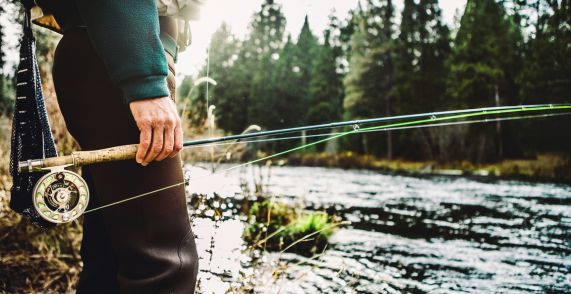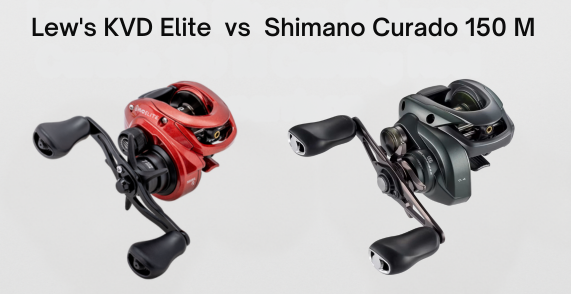There’s a mystique surrounding fly fishing – an art form that connects man, nature, and the elusive fish in a surreal dance. But does this elegance translate into complication?
Startlingly, many novices shy away from fly fishing, considering it more challenging than regular fishing. This blog post aims to debunk such notions by diving deep into the intricacies of both techniques while eyeing at the bigger picture: Which one is genuinely harder?
Fly fishing can be more challenging than regular fishing because it requires a specific casting technique that involves using the energy generated in the rod and weight of the line to create momentum.
Success in fly fishing also depends on understanding the physics involved, reading the river currents, and mastering different fly patterns to match what the fish are feeding on. However, with practice and skill development, many anglers find fly fishing to be an incredibly rewarding and enjoyable experience.
In This Post
- 1 Comparison of Fly Fishing to Regular Fishing
- 2 Skills Required for Fly Fishing
- 3 Challenges in Fly Fishing
- 4 Why Try Fly Fishing?
- 5 FAQ
- 5.1 Q. Are certain types of fish easier to catch with fly fishing than with regular fishing?
- 5.2 Q. Is there a learning curve for mastering fly fishing?
- 5.3 Q. What are some common misconceptions about the difficulty level of fly fishing?
- 5.4 Q. How does the equipment used in fly fishing differ from that used in regular fishing?
- 5.5 Q. What is the main difference between fly fishing and regular fishing?
Comparison of Fly Fishing to Regular Fishing
When it comes to comparing fly fishing and regular fishing, several key differences set these two styles apart.
Firstly, the equipment used in each method varies significantly. In conventional fishing, anglers typically use spinning or baitcasting rods with reels designed to hold monofilament or braided lines.
This setup allows for casting lures or bait into the water and reeling them back in while enticing fish to bite.
It’s like using a slingshot, where the force required to launch the projectile comes from pulling on an elastic band and releasing it.
On the other hand, fly fishing employs a more delicate approach. Anglers use lightweight rods that are specifically designed for fly casting.
Rather than relying on the weight of the lure or bait to propel their line forward, fly fishermen utilize the energy generated by the rod and the weight of the line itself.

By effectively loading and unloading the rod during a cast, they can deliver a feather-light artificial fly onto the water’s surface with precision and finesse.
Imagine trying to delicately place a piece of tissue paper on your friend’s hand without causing it to flutter away – that’s the level of finesse required in fly fishing.
Another significant difference lies in the type of lures used.
Conventional fishing often relies on artificial lures that mimic live bait such as worms or minnows or imitate injured prey fish.
These lures are meant to attract fish through their movement or appearance. In contrast, fly fishing utilizes flies, which imitate different insects or other smaller aquatic creatures that fish might feed on.
Fly fishermen carefully select flies based on what they believe will entice fish in a particular location and time.
Similarly, techniques employed in each style differ as well. In regular fishing, anglers often cast out their lines and then retrieve them using various methods like jigging, trolling, or reeling in slowly.
Fly fishing, on the other hand, involves different casting techniques such as the overhead cast or roll cast. These casts require an understanding of rod loading and timing to generate enough momentum to deliver the fly accurately.
- A survey conducted by the American Fly Fishing Trade Association in 2023 found that 65% of respondents believed fly fishing was more challenging to learn than conventional fishing.
- The same survey revealed that 75% of fly fishermen agreed that mastering casting techniques was particularly difficult, especially when juxtaposed with other fishing methods.
- As per a study by the Michigan Technological University, it has been observed that it takes an average of about 40-60 hours of practice to become proficient in fly casting, far higher than the 10-20 hours needed for competency in spin fishing.
Tackle Used in Both Styles
In addition to differing casting techniques and lures, fly fishing and conventional fishing also utilize distinct tackle. In regular fishing, anglers typically use spinning or baitcasting rods paired with reels that hold monofilament or braided lines.
The choice of rod depends on the target species and fishing technique employed.

For example, a medium-heavy spinning rod with a fast action might be suitable for casting heavy lures or bait into deep water, while a light spinning rod with a slower action can be more appropriate for finesse techniques like drop-shotting for bass.
In fly fishing, anglers wield specialized fly rods that are designed to cast the lightweight fly lines used in this style.
Fly rods are usually longer and more flexible than their conventional counterparts to facilitate delicate presentations and accurate casting. Fly lines are typically made from floating or sinking materials, with different weights and tapers available to suit specific fishing conditions.
Anglers also attach leaders and tippets to the end of their fly line, which help control the movement of the fly on the water and provide invisibility to wary fish.
While conventional fishing commonly incorporates a variety of artificial lures, such as crankbaits, soft plastics, or spoons, fly fishing revolves around using flies tied with feathers, fur, and other materials to mimic natural prey items.
Flies come in various styles, including dry flies that float on top of the water’s surface, nymphs that imitate aquatic insects underwater and streamers that imitate small fish or baitfish.

The selection of flies depends on the target species, location, and the angler’s observations of the fish’s feeding behavior.
Imagine stepping into a fly shop with walls lined with boxes upon boxes of meticulously crafted flies in vibrant colors and intricate patterns – the choices are endless.
Skills Required for Fly Fishing
Fly fishing is a unique form of fishing that requires a specific set of skills to be successful. While it may seem daunting at first, with practice and dedication, these skills can be acquired by anyone willing to delve into the world of fly fishing.

Reading the river is a crucial skill for fly fishing. Understanding where fish are likely to be holding and what they are feeding on is essential for success.
This involves observing the flow of the river, looking for structure such as rocks or fallen trees where fish might take shelter, and identifying insect hatches or other signs of aquatic life that could attract fish.
Getting close to the fish without scaring them is also important in fly fishing. Fish can be easily spooked by sudden movements or disturbances in the water, so learning how to approach stealthily and maintain a low profile is crucial.

This involves wading carefully in the water, using camouflage clothing, and being mindful of shadows and noise.
Mastering the art of drifting the fly perfectly is key. Achieving a natural presentation that mimics the movement and behavior of real insects or other prey requires finesse and control. It’s about making the fly appear as enticing as possible to fool the fish into biting.
Fly selection is yet another skill that comes into play.
Different types of flies imitate various insects or baitfish that fish feed on, so selecting the right pattern for a given situation is crucial.
It involves understanding the local ecosystem, knowing which flies are most effective during different seasons or times of day, and adapting your choices accordingly.
Lastly, patience and perseverance are skills that cannot be overlooked. Fly fishing can be challenging and frustrating at times, but the satisfaction of mastering the necessary skills and connecting with nature in such an intimate way is immensely rewarding.
It may take time to become proficient, but the journey is filled with new discoveries and experiences that make it all worthwhile.
So, whether you’re a beginner or an experienced angler looking to try something new, acquiring these skills will enhance your fly fishing experience and open up a whole new world of angling possibilities.

Mastering the Technique and Understanding Physics
To excel in fly fishing, it’s crucial to master the technique and understand the physics behind it. While casting seems to be the most visible aspect of fly fishing technique, there’s much more to it than meets the eye.
| Fly Fishing Technique | Understanding Physics |
|---|---|
| Casting | In fly fishing, the casting technique involves using the combination of energy generated in the rod and the weight of the line to create momentum and accurately deliver the fly to the desired location. By manipulating various casting strokes like backcast and forward cast, an angler can control distance, accuracy, and presentation. This requires coordination, timing, and practice. |
| Line Management | Fly fishing utilizes lightweight rods and flexible lines compared to their conventional counterparts. The flexibility of a fly line allows for delicate presentations while also facilitating line mending during drifts to avoid drag on the fly. Skillful line management improves control over flies, ensuring optimal drifts and realistic presentations. |
As for physics, understanding how different aspects come into play enhances your ability to adapt and make informed decisions on the water.
For instance, knowledge of fluid dynamics can help you read water currents better, enabling you to position yourself strategically for accurate casts and natural drifts.
A solid grasp of entomology (the study of insects) is essential as well since many fly patterns imitate aquatic insects. Understanding insect life cycles, their behavior, and how fish respond to specific hatches can significantly increase your chances of success on the water.
Consider a situation where you’re fishing for trout in a fast-flowing river with a strong current.
By understanding the concept of hydrodynamics and the fact that fish tend to hold in slower-moving areas behind rocks or other structures to conserve energy, you can strategically position yourself and present your fly more effectively.
By mastering the technique and understanding the underlying physics of fly fishing, you gain greater control over your presentations, improve your ability to adapt to different situations, and ultimately enhance your overall success on the water.

Challenges in Fly Fishing
Fly fishing presents a unique set of challenges that differentiate it from regular fishing. These challenges often add to the allure and excitement of this angling method. Let’s explore some of the key difficulties faced by fly fishers.
One of the primary challenges in fly fishing is mastering the art of casting. Unlike traditional fishing methods where the weight of the lure propels the line, fly fishing requires using the energy generated in the rod and the weight of the line to create momentum.
This delicate technique demands practice and precision to achieve accurate and controlled presentations of flies on the water.
Imagine learning to play a musical instrument, such as the violin or piano. At first, your fingers may fumble and coordination might feel awkward, but with dedicated practice, you gradually develop a rhythm and finesse.
Similarly, in fly fishing, it takes time and effort to become comfortable and proficient in casting.
Casting in fly fishing can be compared to playing a musical instrument – both require practice, patience, and a keen sense of timing.

Another challenge lies in understanding aquatic ecosystems and fish behavior.
Fly fishers must develop an extensive knowledge of fish habitats, their feeding patterns, and preferred prey items.
This involves studying the river or body of water being fished, observing insect hatches, and recognizing other important factors like water temperature and clarity. Identifying fish locations becomes crucial for success.
Picture yourself standing knee-deep in a river filled with trout. You see them leisurely swimming about, occasionally rising to take something off the surface.
To successfully entice these elusive creatures, you need to identify where they are holding within the river and what they are likely to be eating at that particular moment.
Reading currents, riffles, eddies, and identifying subtle changes in water flow can give insight into where fish might be hiding. Being able to match the natural food sources present in the water with suitable fly patterns is essential for enticing fish to bite.
Identifying Fish Locations and Selecting Suitable Flies
Fly fishing isn’t just about casting skills; it also involves a keen understanding of fish behavior and ecosystem dynamics. To increase your chances of success, you must develop the ability to identify where fish are likely to be found and select appropriate fly patterns.
When approaching a river or still water, take a moment to observe its features. Look for calm areas near cover such as rocks, fallen trees, overhanging vegetation, or submerged structures like sunken logs. These spots provide shelter for fish and are prime locations to cast your fly.

Keep an eye out for subtle surface disturbances like rising fish or small ripples caused by feeding activity. These signs indicate that fish are actively feeding on insects or other prey items.
By honing your observation skills, you can pinpoint these areas and position yourself strategically for greater success.
Once you’ve identified potential fish locations, it’s time to choose the right fly pattern.
Different species of fish have specific preferences when it comes to food sources. Research local insect hatches and try to match the size, shape, and color of the prevalent insects with your selection of flies.
It’s important to carry a variety of fly patterns in different sizes and styles to adapt to changing conditions and seasons. Dry flies, nymphs, streamers – each has its own purpose and imitates a different type of aquatic life.
Remember that fly fishing is not just about blindly casting any fly into the water; it requires careful observation, analysis, and selection based on the specific characteristics of the environment you’re fishing in.
Why Try Fly Fishing?
Fly fishing is not just a fishing technique; it’s an experience that offers a unique set of challenges and rewards. If you’re considering delving into the world of fly fishing, here are some compelling reasons to give it a try.
First, fly fishing allows you to connect with nature on a deeper level. Unlike conventional fishing methods that rely on bait or lures, fly fishing involves imitating the natural food sources of fish using delicate flies tied with feathers, fur, and other materials.
This approach requires observation and understanding of the aquatic ecosystem, as well as the ability to read the water to identify where fish are likely to be holding and what they are feeding on.
Fly fishing combines physical skill with mental focus. The casting technique in fly fishing requires practice and coordination between the angler’s arm movement and the energy generated in the rod and line.

It’s a dance-like motion where precise timing and control are necessary to deliver a delicate presentation of the fly. This process can be challenging but immensely satisfying when you achieve that perfect cast.
In addition to the technical aspects, fly fishing offers a sense of tranquility and connecting with nature.
Picture yourself standing in a crystal-clear river, surrounded by picturesque scenery, as you listen to the soothing sound of flowing water.
With each cast, you become tuned in to your surroundings, fully present in the moment. This meditative aspect of fly fishing can provide an escape from daily worries and a chance to find solace in nature.
Imagine yourself gently casting your line onto the calm surface of a secluded lake early in the morning.
A trout rises to your carefully presented dry fly, creating ripples that break the stillness of the water. The thrill of witnessing this interaction between man and fish is unmatched—a shared language between two beings from different worlds.
Fly fishing encourages exploration and adventure.
Whether you’re wading through a river or floating in a drift boat, fly fishing takes you to breathtaking locations that often remain hidden from the average angler.
From remote mountain streams to wide-open saltwater flats, each fishing spot offers its own set of challenges and opportunities. These environments become your playground, where you can discover new places and seek out prized fish species.

Now that we’ve explored the reasons why fly fishing is worth trying, let’s dive deeper into the benefits that it can bring to both beginners and experienced anglers.
The Unique Joy and Precision of Fly Fishing
Fly fishing provides a poetic and immensely satisfying experience.
The delicate presentation required to entice fish demands precision in every aspect of your approach. From choosing the right fly pattern based on the fish’s feeding behavior to presenting it with finesse, every detail matters.
Think of fly fishing as composing a melody on the water. Each cast is like a musical note, carefully chosen and executed with grace.
The way the line unfurls in the air resembles the smooth glide of a bow across violin strings, while the landing of the fly on the water creates a symphony of ripples. Every movement and action become part of an intricate performance that captivates both angler and fish.
The joy in fly fishing lies not only in catching fish but also in honing your skills and connecting with nature.
Whether you’re practicing your casting technique on a calm afternoon or successfully fooling a wary trout with an expertly presented nymph, there is an immense satisfaction that comes from mastering this art form.
It’s about finding harmony between yourself, the rod, and the natural world around you.

FAQ
Q. Are certain types of fish easier to catch with fly fishing than with regular fishing?
Yes, they are. This is because fly fishing allows anglers to present realistic imitations of insects or other small prey on the water’s surface, which can be more effective in luring certain species like trout or salmon.
The delicate and precise casting techniques involved in fly fishing can provide better accuracy and control when targeting specific areas where these fish are known to inhabit.
Statistics reveal that fly fishing has a higher success rate in catching trout compared to traditional bait fishing methods, making it a preferred choice for many angling enthusiasts.
Q. Is there a learning curve for mastering fly fishing?
While regular fishing involves casting and reeling in a baited hook, fly fishing requires a more intricate technique called “casting the fly.”
The angler must learn to delicately cast an artificial fly on the water’s surface to mimic natural insects, requiring precise control of the line.
Mastering the various types of flies, understanding different water currents, and being aware of how fish behave can take time and practice.
According to a survey conducted by Fly Fishers International, 78% of beginner fly anglers reported struggling with casting accuracy and line control when they first started.
Q. What are some common misconceptions about the difficulty level of fly fishing?
One common misconception about fly fishing is that it is more difficult than regular fishing.
While it may seem intimidating, especially to beginners, fly fishing is simply a different technique that requires practice and finesse.
Statistics show that with proper instruction and practice, anglers can become proficient in fly fishing just as they can with other types of fishing. The difficulty level ultimately depends on the individual’s dedication to learning and mastering the technique.
Q. How does the equipment used in fly fishing differ from that used in regular fishing?
The equipment used in fly fishing differs from regular fishing primarily in the rod, reel, and line design.
In fly fishing, anglers use specialized lightweight rods that are longer and flexible to cast the fly line, which is significantly lighter than traditional fishing lines.
Fly reels are simpler and primarily used for line storage rather than drag systems. These differences in gear allow for more delicate presentations, precise casting techniques, and an immersive experience with nature.
Q. What is the main difference between fly fishing and regular fishing?
The main difference between fly fishing and regular fishing lies in the technique and equipment used.
In fly fishing, a lightweight artificial fly is used as bait, which requires casting techniques that involve creating delicate presentations on the water’s surface. Regular fishing, on the other hand, typically uses heavier lures or bait that are cast with spinning reels.
According to a study by the American Fly Fishing Trade Association, fly fishing requires more skill and finesse due to the intricate casting techniques involved, making it a more challenging form of angling overall.







